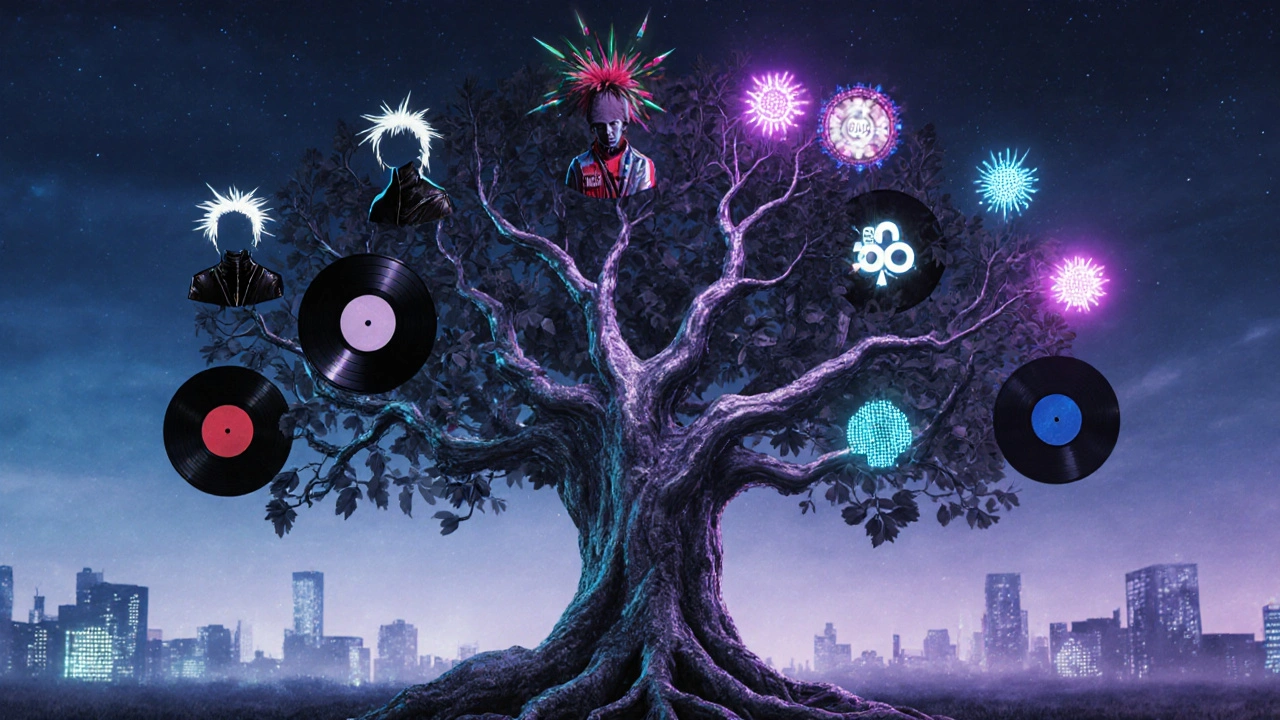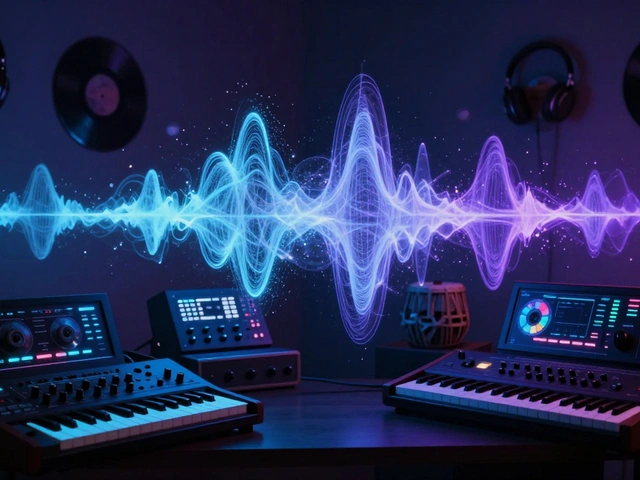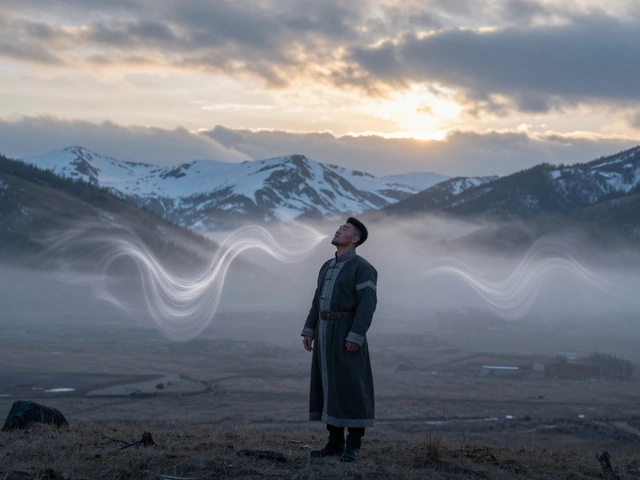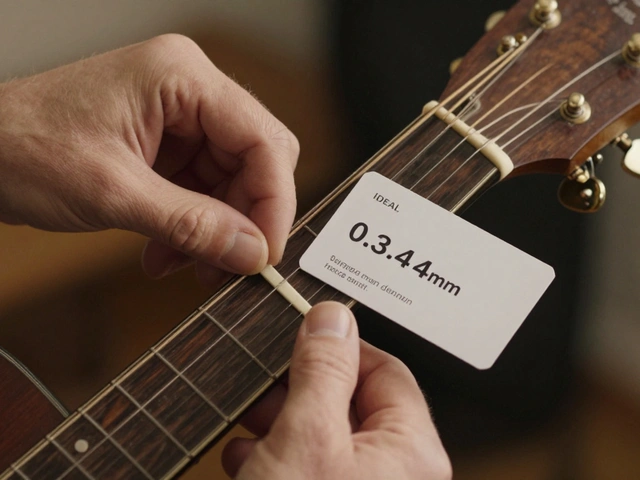Ever listened to a track and thought, ‘This isn’t just pop-it’s something else’? That’s the magic of subgenres. They’re not just labels. They’re sonic identities shaped by culture, technology, and rebellion. If you love music but feel lost in the noise, this guide cuts through the clutter. No fluff. Just clear, real examples of how subgenres form, evolve, and why they matter to your playlist.
What Exactly Is a Subgenre?
A subgenre isn’t a fancy term for ‘kind of music.’ It’s a mutation. A branch that grew off a main genre because someone pushed boundaries. Think of genres as trees. Rock is the trunk. Punk, grunge, and indie rock are branches. Each has its own rules, sounds, and crowd.
Subgenres emerge when artists combine elements in new ways. Maybe a producer adds distorted bass to hip hop. Maybe a band slows down metal and adds haunting vocals. These changes don’t happen overnight. They’re built by local scenes, underground clubs, and DIY studios. Then, slowly, they spread.
Here’s the key: subgenres aren’t just about speed or instruments. They’re about attitude. The difference between classic rock and stoner rock isn’t just the fuzz pedal-it’s the mindset. One celebrates freedom. The other sinks into haze.
Electronic Music Subgenres: From House to Hyperpop
Electronic music has more subgenres than most people realize. And they’re not just ‘techno with a beat.’ Each one has a distinct DNA.
- House started in Chicago in the mid-80s. Four-on-the-floor kick, soulful vocals, warm synths. Think ‘I Feel Love’ by Donna Summer, but darker and deeper.
- Techno came out of Detroit. Cold. Mechanical. Repetitive. It’s not meant to make you dance-it’s meant to make you feel like you’re in a factory at 3 a.m.
- Drum and Bass (D&B) exploded in the UK in the 90s. Fast breakbeats (160+ BPM), deep basslines. It’s jungle music turned into a laser show.
- Trap in electronic form? That’s future bass. Think Flume or ODESZA. Glitchy synths, pitched-up vocal chops, and drops that feel like falling through clouds.
- Hyperpop is the newest kid. It’s like pop music on acid. Pitch-shifted vocals, distorted 808s, and lyrics about anxiety and internet culture. Artists like SOPHIE and Charli XCX turned it into a movement.
These aren’t just sounds. They’re communities. A D&B fan in London doesn’t just like fast beats-they know the history of the jungle rave scene. That’s why subgenres stick.
Hip Hop Subgenres: More Than Just Beats
Hip hop isn’t one thing. It’s a thousand voices. From the Bronx to Brooklyn, from Atlanta to Auckland, it split into subgenres that reflect where they came from.
- Old-school hip hop (late 70s-mid-80s) was about block parties. Turntables, MCs, simple beats. Grandmaster Flash and Run-D.M.C. made it loud and proud.
- Gangsta rap rose in LA in the late 80s. N.W.A. didn’t just rap about crime-they documented it. The music was raw, angry, and real.
- Trap (2000s-now) came from Atlanta. Heavy 808s, hi-hats that roll like rain, lyrics about street life and hustle. Artists like Future and Migos made it global.
- Cloud rap is hazy, dreamy. Think Lil Uzi Vert or Playboi Carti. It’s not about street credibility-it’s about emotion, drugs, and alienation. The beats sound like they’re floating.
- Drill started in Chicago, then exploded in London. Dark, minimalist beats. Lyrics are cold, violent, and direct. It’s not entertainment-it’s testimony.
Each subgenre carries a geography. You can tell where a rapper is from by the rhythm of their syllables. That’s why subgenres matter. They’re maps.

Rock Subgenres: From Punk to Post-Rock
Rock didn’t die. It fractured. And each fracture created something new.
- Punk rock (mid-70s) was rebellion in three chords. The Ramones, The Clash-they stripped rock down to its bare bones. No solos. No fancy production. Just speed and anger.
- Grunge came from Seattle in the early 90s. Nirvana, Pearl Jam. It mixed punk’s rawness with metal’s heaviness. The lyrics were about boredom, depression, and apathy. It wasn’t glamorous. It was real.
- Indie rock didn’t start as a sound. It started as a philosophy: do it yourself. Bands like Pavement and Arcade Fire made music outside the system. No major label. No radio push. Just passion.
- Post-rock is rock without vocals. Think Sigur Rós or Explosions in the Sky. It builds slowly. Swells. Crashes. It’s emotional without words.
- Math rock is for people who like puzzles. Odd time signatures. Complex rhythms. Bands like Don Caballero and toe make music that feels like solving a riddle.
Rock subgenres show how rebellion can turn into art. Punk wasn’t just loud-it was a middle finger to perfection. Grunge wasn’t just dirty-it was honest. That’s why they still matter.
Other Key Subgenres You Should Know
Not all subgenres come from rock or hip hop. Here are a few others that shaped modern music.
- Dubstep (UK, early 2000s): Wobble bass. Silence between beats. Skrillex made it mainstream, but it started in South London basements.
- Lo-fi hip hop (2010s): Chill beats with vinyl crackle. Perfect for studying. It’s not about lyrics-it’s about mood.
- Alt-country: Country music with punk attitude. Think Wilco or Jason Isbell. No fiddles. No twang. Just stories and distortion.
- Neo-soul: A blend of 70s soul, jazz, and hip hop. Erykah Badu, D’Angelo. It’s smooth but deep. Not just background music-it demands attention.
- Emo (2000s): Emotional lyrics. Shouted vocals. Guitar screams. It wasn’t just teen angst-it was therapy set to music.
These subgenres prove you don’t need a big budget or a record deal to make something new. All you need is a feeling and a way to express it.
Why Subgenres Matter to You
Knowing subgenres isn’t about showing off. It’s about finding your people.
When you say you like ‘post-rock,’ you’re not just naming a sound. You’re saying you value atmosphere over hooks. You’re the person who sits through a 10-minute instrumental track because it makes you feel something.
When you say you listen to ‘drill,’ you’re not just naming a genre. You’re acknowledging a culture that speaks truth through pain.
Subgenres help you navigate music. They turn a sea of songs into neighborhoods. You can explore one at a time. Start with one subgenre. Listen to three albums. Then move to the next. You’ll start hearing patterns. You’ll hear how one subgenre borrowed from another. You’ll notice how technology changed the sound-like how Auto-Tune turned into a tool for emotion, not just correction.
And when you find your subgenre, you find your tribe. The people who get it. The ones who know which track to play at 2 a.m. when nothing else fits.

How to Explore Subgenres Without Getting Overwhelmed
There are hundreds of subgenres. You don’t need to know them all. Just start smart.
- Start with what you already like. If you love Radiohead, dig into post-rock and art rock. If you like Kendrick Lamar, explore conscious hip hop and trap.
- Use playlists, not algorithms. Spotify’s ‘Discover Weekly’ is great, but curated playlists by real people are better. Search ‘best lo-fi hip hop 2025’ or ‘essential grunge albums.’
- Listen to the edges. Don’t just listen to the hits. Find the underground. Look up local scenes. A band from Wellington might be blending reggae with ambient electronica. That’s where the next subgenre is born.
- Read liner notes. Old-school albums often explain their influences. A band might say, ‘We were inspired by early dub and Japanese noise.’ That’s your next rabbit hole.
- Ask someone. Talk to a record store clerk. A DJ. A friend who knows more than you. Real people give real recommendations.
Don’t try to learn everything at once. Pick one. Live with it. Then move on.
Subgenres Are Alive-And Changing Fast
Subgenres don’t stay still. They evolve. Hyperpop didn’t exist five years ago. Cloud rap barely had a name ten years ago.
Right now, you’re seeing the rise of:
- Bedroom pop: Lo-fi, intimate, made on laptops. Artists like Clairo and Phoebe Bridgers started here.
- Latin trap: Reggaeton meets hip hop. Bad Bunny, J Balvin. It’s global now.
- Emo rap: A mix of emo, trap, and punk. Lil Peep, Juice WRLD. It’s raw, emotional, and often heartbreaking.
These aren’t trends. They’re movements. They’re made by teens in their bedrooms, not by record labels. That’s the power of subgenres today-they’re democratic. Anyone with a laptop and a feeling can start one.
And that’s why this guide isn’t just a list. It’s an invitation. Go out. Listen. Find your sound. Then help shape the next one.
What’s the difference between a music genre and a subgenre?
A genre is a broad category like rock, hip hop, or electronic. A subgenre is a specific style that grew out of that genre. For example, punk is a subgenre of rock. Trap is a subgenre of hip hop. Subgenres have more specific sounds, rhythms, and cultural roots than their parent genres.
Can a song belong to more than one subgenre?
Absolutely. Many songs blend styles. A track might be both lo-fi hip hop and bedroom pop. Or alt-country and indie rock. Labels are helpful, but music doesn’t care about boxes. Artists often mix influences intentionally. What matters is how the song feels, not what you call it.
Are subgenres just marketing labels?
Some are. Labels like ‘indie pop’ or ‘dance-pop’ are sometimes used to sell music. But many subgenres started from real scenes-underground clubs, college radio, DIY studios. People lived these sounds before they were named. The best subgenres come from culture, not marketing.
How do I find new subgenres?
Start with artists you already like. Look at their influences on Genius or Wikipedia. Check out playlists made by music blogs or local DJs. Follow record stores on Instagram-they often post hidden gems. And don’t ignore your local scene. Some of the freshest subgenres start in small cities or towns.
Do subgenres still matter in the age of streaming?
More than ever. Streaming gives you access to everything, but it also drowns you in noise. Subgenres help you find your way. They’re the compass when you’re lost in millions of songs. Knowing a subgenre means knowing what to expect-and what to avoid. It turns listening into discovery.
Next Steps: Build Your Subgenre Map
Grab a notebook. Or open a new playlist folder. Pick one subgenre you’ve never explored. Listen to three albums from it. Write down what you hear-the instruments, the mood, the lyrics. Then pick one song and find another that sounds similar. Keep going. You’re not just building a playlist. You’re building a map of your musical soul.
There’s no right or wrong. Just curiosity. And that’s the only thing you need to keep exploring.






